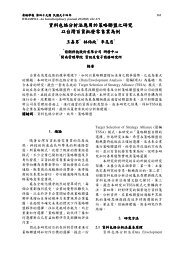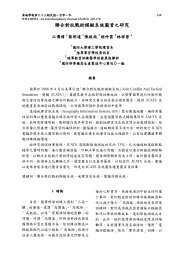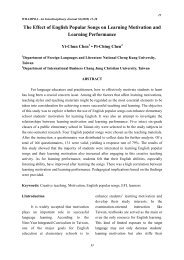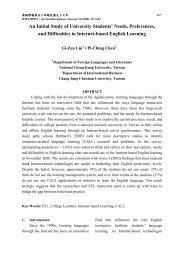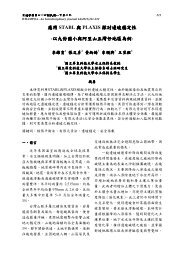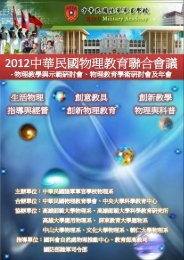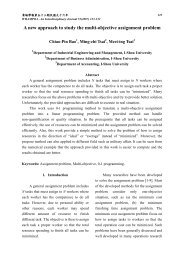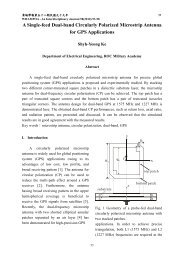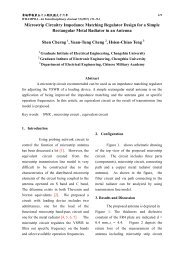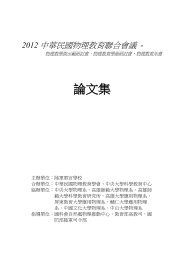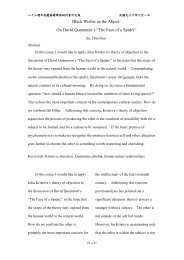Women in Love: the Male / Female Relationships
Women in Love: the Male / Female Relationships
Women in Love: the Male / Female Relationships
You also want an ePaper? Increase the reach of your titles
YUMPU automatically turns print PDFs into web optimized ePapers that Google loves.
158 黃 埔 學 報 第 五 十 一 期 民 國 九 十 五 年<br />
Lawrence conveys <strong>the</strong> colorful obscenities<br />
of <strong>the</strong>ir relationship, its corrosive willfulness<br />
and violent possessiveness, <strong>in</strong> a series of<br />
powerfully dramatized episodes. In <strong>the</strong><br />
“Rabbit” chapter, Gudrun and Gerald<br />
express <strong>the</strong>ir “mutual hellish recognition”<br />
after <strong>the</strong>y are both clawed by <strong>the</strong> rabbit,<br />
Bismarck (234). Gerald’s desire for<br />
dom<strong>in</strong>ation and its l<strong>in</strong>k to violence emerges<br />
when W<strong>in</strong>ifred decides to “frame” ano<strong>the</strong>r<br />
animal by draw<strong>in</strong>g it. When Gudrun tells<br />
Gerald, “We’re go<strong>in</strong>g to draw [<strong>the</strong> rabbit],”<br />
Gerald replied, “Draw him and quarter him<br />
and dish him up” (230). Gudrun smiles at<br />
Gerald’s mockery and <strong>the</strong>ir eyes meet <strong>in</strong> <strong>the</strong><br />
knowledge of <strong>the</strong>ir <strong>in</strong>herent cruelty. They<br />
give full expression to <strong>the</strong>ir mutual<br />
attraction to such power plays when <strong>the</strong>y try<br />
to remove <strong>the</strong> rabbit from its cage--ano<strong>the</strong>r<br />
fram<strong>in</strong>g image. Its frenzied opposition<br />
thwarts Gudrun’s attempt to capture, “a<br />
heavy cruelty well[s] up <strong>in</strong> her,” which<br />
Gerald observes her sullen passion of cruelty<br />
“with subtle recognition” (232). Gerald<br />
responds with similar outrage when he tries<br />
to subdue <strong>the</strong> rabbit and, like Gudrun, is<br />
scratched. This event turns out to be<br />
curiously ritualistic; once aga<strong>in</strong> both lovers<br />
acknowledge <strong>the</strong>ir subterranean attraction<br />
and so reaffirm <strong>the</strong> twisted pact between<br />
<strong>the</strong>m:<br />
Gudrun looked at Gerald with strange,<br />
darkened eyes, stra<strong>in</strong>ed with underworld<br />
knowledge, almost supplicat<strong>in</strong>g, like<br />
those of a creature which is at his mercy,<br />
yet which is his ultimate victor. He did<br />
not know what to say to her. He felt <strong>the</strong><br />
mutual hellish recognition. (234)<br />
Tak<strong>in</strong>g <strong>the</strong>ir lead from such dubious currents<br />
of feel<strong>in</strong>g, Gerald and Gudrun proceed to<br />
engage <strong>the</strong>mselves <strong>in</strong> a program of sexual<br />
warfare and violence, deny<strong>in</strong>g <strong>the</strong>ir potential<br />
capacity for true connection. That Gudrun<br />
and Gerald unite at <strong>the</strong> end of “Rabbit”<br />
chapter <strong>in</strong> “mutual hellish recognition”<br />
becomes an apt metaphor for <strong>the</strong> complexity<br />
of male / female relationships.<br />
Gerald desperately seeks out Gudrun<br />
as his primary source of verified existence,<br />
his only source of work<strong>in</strong>g stimulation.<br />
Rendered helplessly by his own empt<strong>in</strong>ess,<br />
Gerald dra<strong>in</strong>s whatever sustenance he can<br />
from Gudrun: “As he drew nearer to her, he<br />
plunged deeper <strong>in</strong>to her envelop<strong>in</strong>g soft<br />
warmth, a wonderful creative heat that<br />
penetrated his ve<strong>in</strong>s and gave him life aga<strong>in</strong>.<br />
He felt himself dissolv<strong>in</strong>g and s<strong>in</strong>k<strong>in</strong>g to rest<br />
<strong>in</strong> <strong>the</strong> bath of her liv<strong>in</strong>g strength” (337).<br />
Ironically, Gudrun also derives a k<strong>in</strong>d of<br />
passive pleasure from this strange<br />
experience: “and she, subject, received him<br />
as a vessel filled with his bitter potion of<br />
death. She had no power at this crisis to<br />
resist. The terrible frictional violence of<br />
death filled her, and she received it <strong>in</strong> an<br />
ecstasy of subjection, <strong>in</strong> throes of acute,<br />
violent sensation” (337). Both Gudrun and<br />
Gerald transform <strong>the</strong>ir capacity for normal,<br />
healthy sexuality <strong>in</strong>to lust and assertiveness.<br />
In do<strong>in</strong>g so, <strong>the</strong>y make <strong>the</strong>mselves <strong>in</strong>to<br />
agents of death.<br />
“The <strong>in</strong>terchanges between men and<br />
women <strong>in</strong> <strong>Women</strong> <strong>in</strong> <strong>Love</strong>,” as Wendy<br />
Perk<strong>in</strong>s observes, “are complicated by <strong>the</strong><br />
historical moment of <strong>the</strong> novel, an age<br />
where <strong>in</strong>dividuals no longer turn to society<br />
for advice on form<strong>in</strong>g relationships” (233).<br />
Perk<strong>in</strong>s fur<strong>the</strong>r remarks: “As Ursula, Birk<strong>in</strong>,<br />
Gudrun, and Gerald struggle to ga<strong>in</strong><br />
knowledge of <strong>the</strong>mselves through contact




